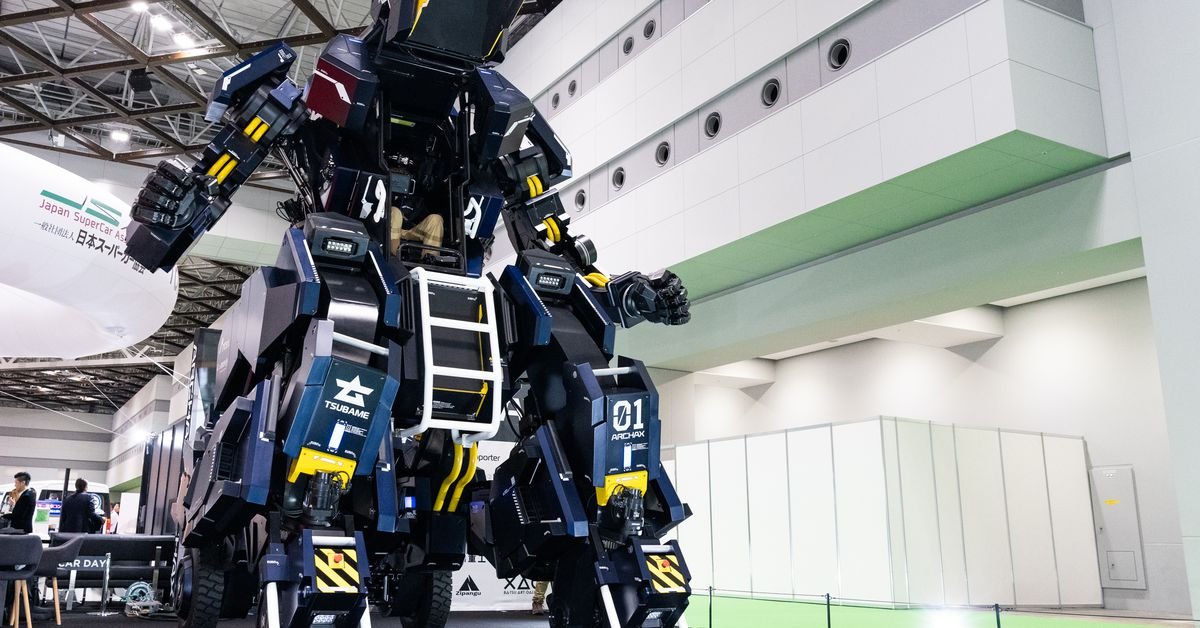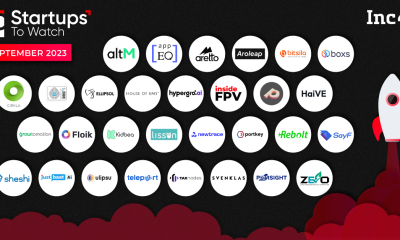The multimillion-dollar hypercar business is booming. The world’s ultra-wealthy have dozens and dozens of different outrageously expensive, high-performance toys to choose from, like the Rimac Nevera or the Mercedes-AMG Project One. Some are so extreme, they’re not even street-legal.
Science
The Tsubame Archax is the coolest $3 million mecha on Earth — and soon, the Moon

[ad_1]
But what’s a tech-forward multibillionaire who’s more into anime than motorsports to do with their discretionary fund?
The Tsubame Archax might be the answer. This is, quite simply, a Gundam fan’s dream made a reality: a 15-foot-tall, $3 million mecha that works just like the real thing — well, minus a few pesky details like jet boosters, laser swords, and the neural interfaces explored in many of Gundam’s various (and conflicting) timelines.
Made in Japan
You don’t earn any bonus points for guessing where this thing was made. It’s at the Japan Mobility Show, where I got up close and personal with the $3 million machine and spoke with the team behind it. The first product of Yokohama-based Tsubame, Archax is the result of four years of research and development.
And what a result it is. Inside the Tokyo Big Sight exhibition hall, a massive place by any standard, Archax towers over the pedestrian supercars and concept machines that dot the space. Every hour or so, Tsubame employees run it through a simple demo, where it lifts its arms, waves to the crowd, and transforms from Robot mode to Vehicle mode and back again.
Yes, the Archax is a Transformer of sorts. Like the Autobots, it can roll out, but you won’t be confusing this for a VW Beetle or Kenworth K100. Here, it’s more like morphing between two variations on the same theme.
A quadruped on wheels
The Archax has four legs, but it doesn’t walk on them as such. At the bottom of each is a Yokohama industrial tire of the sort you’d mount on a forklift, each driven by an electric motor. In Vehicle mode, Archax’s four legs are spread apart, lowering the center of gravity and enabling its maximum speed of about 6mph.
But for wowing your friends or scaring your neighbors, convert it into Robot mode, and it rises to its full height of 15 feet.
The transformation is simple by Optimus Prime standards but still quite a sight to behold — and to hear. Myriad electric motors throughout the chassis all whir into action to hoist the 3.5-ton machine up to its full height, a process that takes about 15 seconds.
The Archax is a Transformer of sorts
That’s nothing compared to the drama of the cockpit opening mechanism. From the outside, the pilot needs to hold a switch situated on the bottom left of the Archax’s chassis. Four separate hatches move in sync to provide access to the lone driver’s chair inside, a fluid motion that is very much inspired by Gundam robots.
In fact, everything was inspired by the Gundam series. Tsubame CTO Akinori Ishii is the technical director at the Gundam Global Challenge, the group responsible for the full-size Gundam RX-78F00 — which also lives in Yokohama.
“The designer, he is a young Japanese, inspired by so many animations,” Ishii told me. “It’s his original design, but I think the essence came from the Gundam animation.”
Business goals
The project as a whole is the brainchild of CEO Ryo Yoshida, who posted early pictures of the Archax design on Twitter. Ishii messaged him on there and was hired to help bring the project to life.
“The first step is focused on the hobbyist and entertainment,” Ishii told me. But the company has bigger goals than that. After all five units of the Archax are sold out, Ishii wants to take a cue from the 2014 Godzilla reboot and let them fight.
Inspired by the Gundam series
Tsubame wants to create a sort of robot combat league, but not with giant mechs beating each other down Robot Jox-style. “We want to fight using a few units. Not actual combat, but using virtual reality, so in the actual reality using real robots, the fighting is using the virtual reality technology, like a game,” he said. So imagine real robots zipping around a real battlefield, launching Itano Circus-style volleys of virtual missiles at each other. “That is the next step.”
But even that is small in comparison to where Ishii eventually wants the company to go: space and, more specifically, the Moon. Ishii formerly worked as an engineer at Hitachi, a global manufacturer that sells hundreds of construction and excavation machines, many of which are optimized for specific tasks.
“On Earth, there are many specialized machines for special work,” he said. “On a moon base, we are not able to have so many machines. So, maybe a human-like machine will be used in such a situation.”
Down to earth
That’s a long way to go, both literally and metaphorically considering today’s Archax can’t really do much of anything useful. It can lift objects in its hands, up to about 20 kilograms (44 pounds), but the big mech isn’t really suited for precise work. Basic controls are a pair of joysticks for controlling the arms, with a touch panel through which the pilot can toggle discrete functions like lights and modes.
A pair of pedals control the Archax’s movement. The one on the right rocks forward and back to control speed ahead and in reverse. The pedal on the left rocks side to side and is used to turn the mech.
Tsubame wants to create a sort of robot combat league
The cockpit is completely enclosed, again like a Gundam, with the pilot seeing the world through footage captured from 26 wide-angle cameras that you can see scattered around the mech. That footage is then stitched together on a trio of displays that enclose the pilot.
The final controls? Big red emergency stop buttons, found not only inside the cockpit but also outside on the legs. Safety is very definitely a priority for Ishii and the rest of the Tsubame team, all of whom donned helmets whenever the thing was in motion.
It’s quite a sight to behold when it moves, and I know that by now you’re surely wondering what it’s like to pilot the thing. Sadly, that’s a question I can’t answer. “Only the person who purchased the Archax can ride it,” Yoshida told me after I asked (repeatedly) for a go. That is a little out of my price range, a situation that won’t change soon.
I asked Ishii whether a next-generation Archax might be a little more affordable. He pondered the question for a few moments and then laughed.
[ad_2]
Science
Starlink Mini brings space internet to backpackers

[ad_1]
SpaceX’s Starlink internet-from-space service is already available for boats, planes, vanlifers, Amazonian villages, and rural homes in over 75 countries — now it’s coming to backpackers.
The new compact DC-powered Starlink Mini is about the size of a thick laptop and integrates the Wi-Fi router right inside the dish. And despite using less power than other Starlink terminals, it can still deliver speeds over 100Mbps.
“This product will change the world,” claimed SpaceX CEO Elon Musk on X, saying it took less than five minutes to setup.
Notably, the Mini kit consumes an average of just 20-40W compared to the 33-62W we measured just two years ago with a Standard Actuated dish and separate AC-powered Wi-Fi router. That means you can power the Mini dish for two to three hours from something like an Anker Prime 27,650mAh (99.54Wh) power bank, or a little over an hour with smaller 10,000mAh (40Wh) portable batteries you probably already have laying about. It requires a USB-C PD power source with a minimum rating of 100W (20V/5A).
The Mini dish measures 11.75 x 10.2 x 1.45 inches (298.5 x 259 x 38.5mm) and weighs just 2.43 pounds (1.1kg), or 3.37 pounds (1.53kg) with the 49.2 foot (15m) DC power cable and kickstand. It has an IP67 rating meaning it’s protected from dust and rain, including short periods of water immersion.
In the US, Starlink Mini is an add-on to Residential plans — at least for now. The Mini kit costs $599 which is $100 more than the standard dish, and will cost an extra $30 per month to add the Mini Roam service to existing $120 Residential plans. That gives Starlink Mini users up to 50GB of mobile data each month, with the option to purchase more for $1 per GB, according to early-access invitations sent to some exiting US Starlink customers.
While Starlink Mini is new to the US, a Starlink support page says it’s already available in Colombia, El Salvador, Guatemala, and Panama where it can be purchased with Mini Service or Mobile – Regional Service plans. In those countries, there’s no data or speed caps to use Mini, and in-motion and ocean use is not allowed. SpaceX says it’ll expand to more markets over time.
“Our goal is to reduce the price of Starlink, especially for those around the world where connectivity has been unaffordable or completely unavailable,” reads the Starlink support page. “In regions with high usage, like the US, where Starlink Mini places additional demand on the satellite network, we are offering a limited number of the Starlink Mini Kits to start at a higher price point.”
As a standalone service, Starlink Mini could be transformative for anyone in need of an inexpensive and sharable internet service that efficiently sips DC battery power. This includes families that depend upon a cobbled together solar generator for power, a squad of soldiers trying to fight back an invasion, or just bikepackers and overlanders taking the road less traveled.
[ad_2]
Source link
Science
Elon Musk has another secret child with exec at his brain implant company

[ad_1]
Elon Musk, who has long touted claims about the world’s supposed depopulation crisis, had another child with an executive at his brain implant company Neuralink, according to a report from Bloomberg. Neuralink director Shivon Zilis reportedly had the child with Musk earlier this year.
As noted by Bloomberg, Musk has repeated that line several times in the past, including during a 2022 interview with Tucker Carlson and again during an interview at the Milken Institute conference in May. He told Carlson “a collapsing birth rate is the biggest danger civilization faces, by far.” In 2021, Musk’s nonprofit organization donated $10 million to the University of Austin to fund the Population Wellbeing Initiative, a research group that studies the human population.
The revelation also follows multiple reports alleging inappropriate conduct from Musk in the workplace and with subordinates. A recent report from The Wall Street Journal said Musk had a sexual relationship with a former SpaceX intern who later became one of the company’s executives. Another employee says she refused Musk’s requests to have children with him several times, according to the Journal.
[ad_2]
Source link
Science
Youth plaintiffs in Hawaii reach historic climate deal

[ad_1]
A group of young plaintiffs reached a historic climate settlement with the state of Hawaii and Hawaii Department of Transportation in a deal that will push the state to clean up tailpipe pollution.
The 13 youth plaintiffs filed suit in 2022 when they were all between the ages of 9 and 18. In the suit, Navahine F. v. Hawaii Department of Transportation (HDOT), they alleged that the state and HDOT had violated their right to “a clean and healthful environment,” which is enshrined in Hawaii’s constitution.
“We got what we came for, and we got it faster than we expected.”
The settlement, reached on Thursday, affirms that right and commits the DOT to creating a plan to reach zero greenhouse gas emissions from transportation by 2045. To hit that goal, the state will have to dedicate at least $40 million to building out its EV charging network by the end of the decade and complete new pedestrian, bicycle, and transit networks over the next five years. The settlement also creates a new unit within HDOT tasked with coordinating CO2 emission reductions and a volunteer youth council to advise HDOT.
“I am so proud of all the hard work to get us to this historic moment. We got what we came for, and we got it faster than we expected,” the lead plaintiff, Navahine F., said in an emailed statement.
Back in 2018, Hawaii committed to reaching net-zero carbon dioxide emissions by 2045 — in line with what climate research determined was necessary to meet the Paris climate accord goal of stopping global warming. But the state wasn’t doing enough to reach that goal, the plaintiffs alleged. Transportation makes up the biggest chunk of the state’s greenhouse gas pollution.
“Climate change is indisputable,” Ed Sniffen, HDOT director of transportation, said in a press release. “Burying our heads in the sand and making it the next generation’s problem is not pono.”
Youth in Montana scored another historic legal win last year after the first climate case of its kind to go to trial. A state court found that a Montana policy that barred officials from considering the consequences of climate change when permitting new energy projects violated the rights of the plaintiffs to a “clean and healthful environment.” The lawsuit in Hawaii was expected to be the next landmark youth climate case to go to trial in the US. Several other state and federal youth climate suits are still pending in the US.
[ad_2]
Source link
-

 Startup Stories9 months ago
Startup Stories9 months agoWhy Millennials, GenZs Are Riding The Investment Tech Wave In India
-

 Startup Stories9 months ago
Startup Stories9 months agoStartups That Caught Our Eyes In September 2023
-

 Startup Stories9 months ago
Startup Stories9 months agoHow Raaho Is Using Tech To Transform India’s Fragmented Commercial Trucking
-

 Startup Stories8 months ago
Startup Stories8 months agoMeet The 10 Indian Startup Gems In The Indian Jewellery Industry’s Crown
-

 Crptocurrency4 months ago
Crptocurrency4 months agoLither is Making Crypto Safe, Fun, and Profitable for Everyone!
-

 Startup Stories9 months ago
Startup Stories9 months agoHow Volt Money Is Unlocking The Value Of Mutual Funds With Secured Lending
-

 E-commerce9 months ago
E-commerce9 months agoTop Online Couponing Trends To Watch Out For In 2016
-

 Startup Stories9 months ago
Startup Stories9 months agoWhy Moscow-Based Kladana Considers Indian SME Sector As The Next Big Market For Cloud Computing




